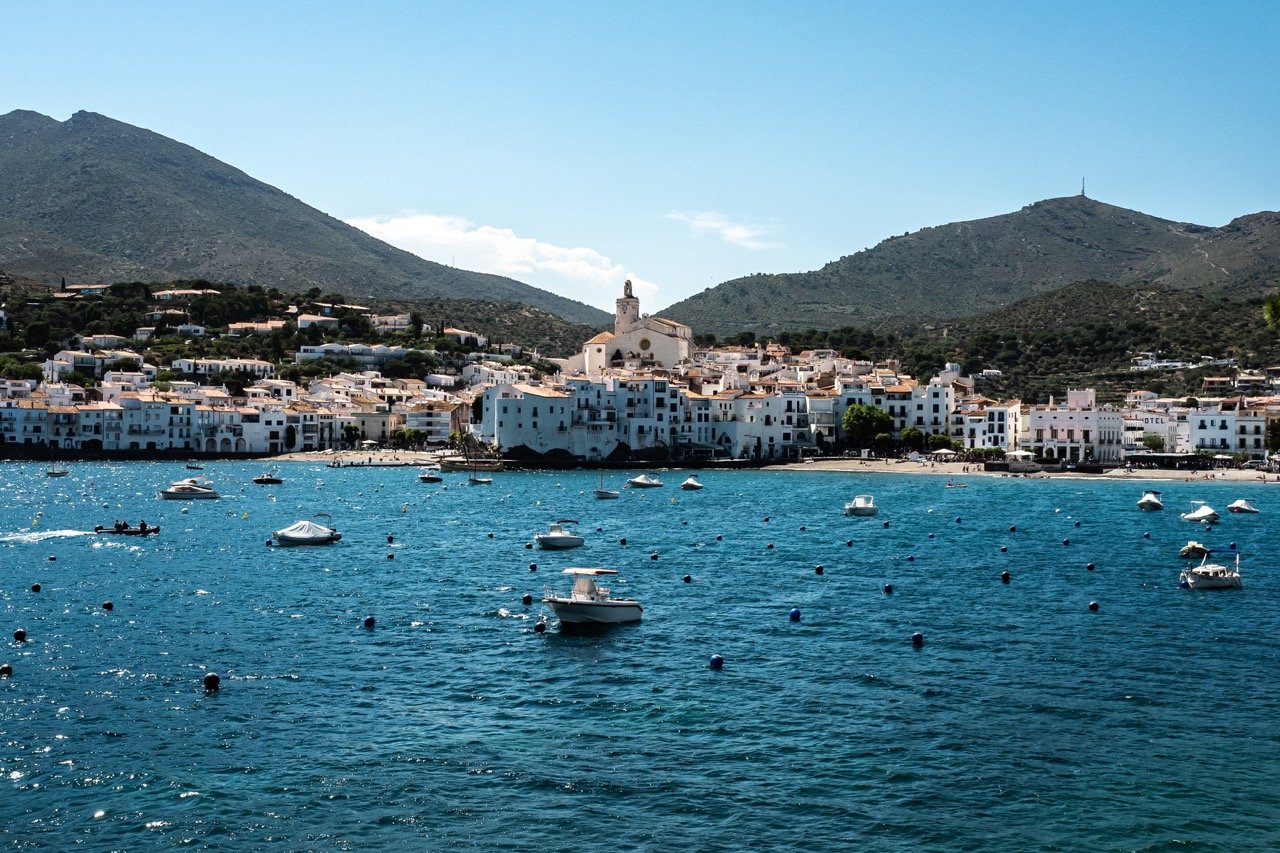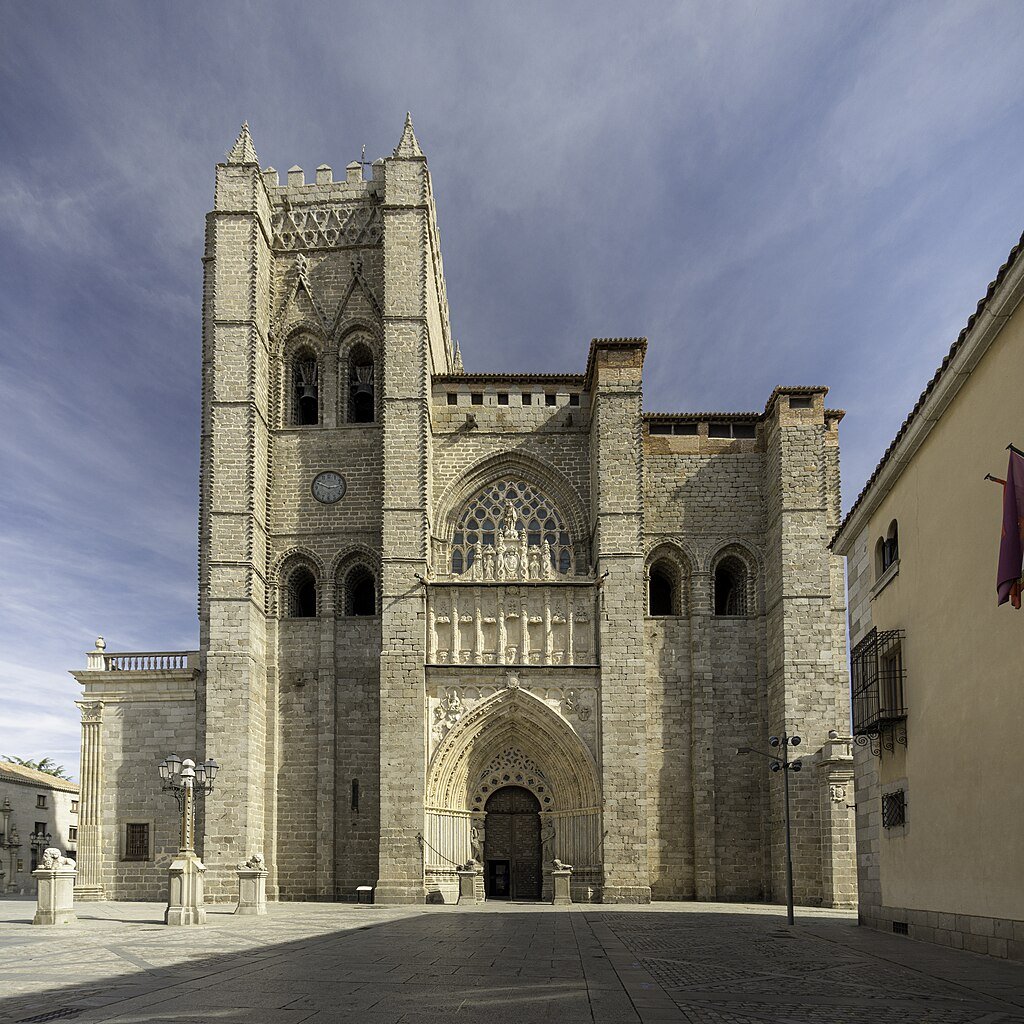Travel Guide to Ávila, Spain
Affiliate disclosure: some of the links in this article are affiliate links. If you book using one of them, we’ll earn a small commission. All of our info is free to read and free of ads, so we appreciate it!
Ávila is one of those Spanish cities steeped in medieval grandeur, offering visitors architectural splendor a-plenty. By far, the city walls are amongst the most well preserved in all of Europe, and certainly the most intact that can be found in Spain. Encircling the city’s historic core and adorned with epic entry gates, watchtowers, and turrets, Ávila is a place that has stood the tests of time.
It’s also a city that is famous in Spain for one character in particular – Saint Teresa. A noblewoman turned devout nun, she became well known as a spiritual leader who revitalized the Carmelite religious order within the Roman Catholic Church, authoring several classic books on spiritualism and founding monasteries across Spain.
With Ávila as the Saint’s home base, the city has become a site of religious pilgrimage, and is steeped in a historic atmosphere, only elevated thanks to the addition of several palaces, Romanesque churches, and ancient monasteries. With so much history to explore, a trip to Ávila is a journey into the essence of old Spain.
More Spain travel info:
For more info on travel in Spain, check out our 2-week Spain itinerary and our article on how to plan a trip to Spain.
And if you could use some one-on-one help planning your itinerary, schedule a Spain travel consultation with one of our Local Experts!
Table of Contents
Why visit?
Where is Ávila
How to get there
How long to spend
Things to see & do
How to spend a day in Ávila


Why visit?
As already mentioned, Ávila’s most striking feature is its exceptionally well-preserved medieval walls, hemming in the entirety of the city’s historic core. These formidable fortifications date to the 11th century, and unlike many other places in Spain, the walls remain intact, creating a distinctive medieval atmosphere for travelers.
Dotted with battlements, watchtowers, and grand gates that grant entrance into the historic core, the walls surround churches, convents, and palace compounds. The historic significance of the city can’t be understated; a visit will vault you right back to a time when Spain was an epicenter of knights and monks, battles, and religious fervor.
On top of the medieval history that’s on show, Ávila also evokes a serene and contemplative vibe. The city has a deep spiritual significance, rooted in the life of Saint Teresa of Ávila, a prominent mystic and writer who was born here in the 16th century. Her life as a Carmelite nun and her profound spiritual journey left a clear mark on the religious landscape in Spain. Visitors can explore the Convent of Saint Teresa, where her relics are preserved, and gain insights into her profound spirituality.
In short, Ávila is a place where faith, history, and architecture all combine, offering a fantastic glimpse into Spain’s storied past.
Where is Ávila?
Ávila is in the autonomous community of Castile and León and is the capital of the region’s most populous municipality, also called Ávila. Roughly 62 miles west of Madrid, the Spanish capital, it’s elevation at 3,714 feet (1,132 meters) places it as the highest provincial capital in the country.
That elevation is thanks in large part to the windy and flat plateau that makes up most of Castile and León. But the city sits above even that, perched atop a rocky hill that rises abruptly from the landscape.
Surrounded by brown, arid, treeless tableland, the one defining geographical feature is the Sierra Gredos to the south, an imposing mountain range that provides a stunning backdrop to offset the arid plains.

Connect with one of our Spain-based local experts for help perfecting your itinerary, answers to all your travel questions, and fabulous local tips!
How to get here
Ávila is a popular option for a day trip from Madrid, with convenient ways to get here by train, bus, and car.
Arriving by train
Trains to Avila from Madrid depart from the Madrid-Principe Pio Station, with trains leaving at least every hour throughout the day. The trip takes about 1.5 hours and tickets cost from €11 to €17.
See timetables and fares at https://www.renfe.com/es/en, the website for RENFE, Spain’s national rail carrier.
Arriving by bus
Alternatively, buses from Madrid are another option, and the trip takes a little over an hour, with six departures a day. Tickets cost between €9 and €15 per person.
Driving to Ávila
If you have your own car, the distance between Madrid and Ávila is approximately 68 miles (109.7 kilometers), and the drive takes just over 1 hour.
The quickest route involves taking the AP6 and then the AP51 (both toll roads). However, if you prefer a more scenic drive, consider taking the M-501 towards San Martín de Valdeiglesias, followed by the N-403 up to Ávila.
Parking: Once you arrive, Ávila offers various parking options. Your best bet is the Parking El Grande underground lot, which sits just below the Plaza de Santa Teresa right outside the city walls.
Renting a car
DiscoverCars is an online aggregator that includes offerings from all the major international rental companies as well as lots of smaller local agencies, which often have much better pricing. If you plan on renting a car, I always recommend checking prices on it as you can frequently find great deals.
AutoEurope is another aggregator that I really like. It tends to be more expensive, but they only list options from large, well-reviewed companies and their customer service is excellent. Their deals often include “zero deductible” rental insurance and they’re the best option if want the easiest experience and are ok paying a little more for it.
How long to spend in Ávila
A full day is all you need to see Ávila, which is why it’s such a popular day trip from Madrid. Spending your day exploring the walls, the historic core, and visiting the cathedral and Saint Teresa Monastery will give you a fantastic overview of this place’s significance in Spanish history.
While you can comfortably visit as a day trip from Madrid, I would suggest spending the night in town. After the day-trippers from Madrid have returned to the capital, the quiet, medieval streets in Ávila’s historic core take on a very beautiful atmosphere. Plus, seeing the walls illuminated after dark is worth the cost of a hotel.
Where to stay in the city
Speaking of hotels, the fantastic Parador of Ávila makes for a great choice of overnight stay. This Renaissance palace within the walls has been converted into a stunning hotel that pays homage to the original style of the palace from the 16th century.
For something more affordable, Hotel Palacio Valderrábanos offers direct views of the cathedral for a very affordable price.
Prices for these hotels range from about $75-$150 USD per night.

What to see & do
1. The Medieval Walls of Ávila
Whether approaching by bus or on foot from the train station, the first sight that will capture your imagination is undoubtedly the formidable Walls of Ávila. Listed as a UNESCO World Heritage site, they’re the most intact medieval fortifications in all of Spain.
The walls span the perimeter of Ávila’s historic core, in total measuring around 1.5 miles (2.5km) and never less than three meters thick. The eastern side, most vulnerable to attack, remains the oldest and most reinforced section.
Visitors can also climb two different sections of the wall: the first is a 300-meter stretch accessible from just inside the Puerta del Alcázar, offering breathtaking views. The second is a 1,300-meter stretch along the old city’s northern perimeter.
2. The Catedral de Ávila
Considered Spain’s first Gothic cathedral, the Catedral de Ávila resembles somewhat of a fortress, blending into the city walls behind it and boasting a collection of intimidating battlements. This somewhat intimidating façade conceals an exquisite interior, with soaring limestone columns supporting the domed ceilings far above, from where sunlight filters through stained-glass windows.
The carved choir stalls and altar are highlights, while a museum inside features a painting by El Greco.
The Cathedral of Ávila. Photo: Fernando, CC BY-SA 4.0, via Wikimedia Commons
3. The Convent of Santa Teresa
The Convent of Santa Teresa, erected in 1636 atop where Saint Teresa of Avila was born in 1515, serves as the focal point of reverence for the saint. It’s a site of pilgrimage for many, and inside offers an interesting look at Teresa’s life as a spiritual leader.
There’s a church, a relic room, and a museum, while the opulent chapel features a striking baroque altar adorned with a statue of the saint and a noteworthy sight – the ring finger from one of her hands.
The Convent of Santa Teresa. Photo: Håkan Svensson, CC BY-SA 3.0, via Wikimedia Commons
4. Los Cuatro Postes Mirador
Northwest of Ávila, along the road leading to Salamanca, lies Los Cuatro Postes, a mirador that offers unparalleled vistas of the city's iconic walls. This site holds historical significance as the place where Santa Teresa and her brother were intercepted by their uncle in their attempt to flee home, aspiring to martyrdom at the hands of the nearby Moors.
It’s a favorite spot for sunset views over the city, with the walls slowly lighting up as evening falls. To get here, it’s about a 20-minute walk from the Plaza del Mercado, one of the central points of the old town.
Los Cuatro Postes. Photo: Aloriel, CC BY-SA 3.0, via Wikimedia Commons
5. The Basilica of San Vicente
The Basilica of San Vicente is one of Ávila’s Romanesque marvels, constructed between the 11th and 14th centuries. The church was built on the site where three martyrs, Vicente and his two sisters Sabina and Cristeta, died in defiance of the Romans back in the 4th century.
The interior shrine portrays their story, while the architecture pays homage to the beautiful artistry of the Romans with a few Gothic flourishes added in.
Basilica of San Vicente. Photo: Fernando, CC BY-SA 4.0, via Wikimedia Commons
6. The Church of San Pedro
Another Romanesque church worth checking out in Ávila is the Church of San Pedro. Construction began in the 12th century, with the Romanesque style influenced by the Gothic design principles that swept across Spain in the following years.
You’ll find the church anchoring the eastern side of the large Plaza del Mercado Grande, a stunning focal point of the square.
7. Try the local specialties
Ávila is home to many specialties when it comes to food, but it’s hard to pass up a chance to try the Chuletón de Ávila. This substantial steak is cut from the Avileña-Negra Ibérica breed of cattle, known for its rich flavor and tenderness. Traditionally grilled and served somewhat rare, it’s a simple yet exquisite dish that celebrates the quality local produce with minimal seasoning, often only accompanied by potatoes, lettuce, and a sprinkle of thyme.
Other must-try dish are the patatas revolconas, a hearty dish of mashed potatoes mixed with pork scratchings and spices, and Judiones del Barco, a bean stew with bits of bacon, chorizo, and blood pudding, perfect if you’re visiting in winter.
Restaurante La Santa, Mesón Gredos Bar Restaurante, and Restaurante El Buen Yantar are all good places to try these dishes.
For sweets, the Yemas de Santa Teresa (Yolks of Santa Teresa) is a treat that you can find all throughout Spain, but which hails from Ávila. This is a pastry made from egg yolks combined with a syrup that’s been reduced together with lieon juice and cinnamon, and cooked at low heat.
8. Monasterio de Santo Tomás
Southeast from the Jardín de San Vicente along Calle de Ferrol Hernandez and Avenida del Alférez Provisional leads to the Monastery of Saint Tomas, one of Spain’s National Monuments. Commisioned by the Reyes Católicos, Fernando and Isabel, and completed in 1492, this monastery is a remarkable work of architecture and a building with plenty of historical significance.
Inside, you can visit Don Juan’s tomb, the monarch’s sole heir, and explore three distinct cloisters dedicated to different aspects of monastery life. It provides an interesting insight into life as a Middle Ages monk as well as the Spanish royal history.
One of the monastery’s cloisters. Photo: Pizicato Elena, Public domain, via Wikimedia Commons
9. The Museum of Ávila
If you haven’t gathered by now, there’s a lot of history to absorb in this city. To get a good overview of it all, head to the fantastic Museum of Ávila. Inside, displays spanning archaeology, ethnology, and fine art deliver a wealth of information about the city and the surrounding region.
Expect to learn about traditional folk costumes, farming tools and antique domestic wares, and the cultural and religious dynamic that played out within the city walls.
10. Monasterio de la Encarnación
Situated just beyond the northern boundary of Ávila’s historic city walls, the austere yet elegant monastery stands as a place where Saint Teresa embraced her monastic life for nearly three decades. Inside, visitors can explore three main chambers, one of which is the hallowed site where Saint Teresa is said to have met a divine vision of the baby Jesus.
The monastery is also home to several sacred relics, including the wooden plank Teresa used as a pillow during her travels across Spain.
11. Hang out in Parque San Antonio
On hot summer days, a shady respite can be found beneath the trees of the Parque San Antonio, right next to the city’s train station. Here, walkways meander through the shady area, with locals meeting on the grassy lawns to hang out with friends, picnic, and watch their children at the playground.

Our local experts have answers!
Connect with our Spain-based experts for help perfecting your itinerary, fabulous local tips, and expert advice on your trip planning!
How to spend a day in Ávila
Assuming you’ll begin your journey here in Madrid, catch the first bus or train out of the city so that you arrive in Ávila relatively early. From the station, stroll through the Parque San Antonio as you make your way into the historic core.
Your first stop should be the Catedral de Ávila, where you can venture inside to admire the stunning interiors. After, head south through the center to reach the Puerta del Alcázar, which connects the old town with the Plaza del Mercado Grande, a nice square where you can grab a coffee.
Then, back inside the gate, stairs lead you up onto the city walls, from where you can enjoy some stellar views.
For lunch, back down on the Plaza del Mercado Grande try the local steak, chuletón de Ávila, at Barbacana or Restaurante La Santa.
After lunch, head west through the city to the Convent of Santa Teresa to learn about the spiritual leader’s life. Then, head north through the central Plaza del Mercado Chico to reach the northern section of the wall, where you can again climb onto the ramparts for some great views over the city.
As the day begins to fade, make the 20 to 30-minute walk out to Los Cuatro Postes Mirador. This is the best spot in the city to catch the sunset, watching as the shadows fall over Ávila and become illuminated by the streetlights.
For dinner, Plaza del Mercado Chico makes for an atmospheric spot to enjoy a meal. Try Mesón Gredos Bar Restaurante or Restaurante El Buen Yantar, both with a wide variety of tapas as well as local specialties.





Connect with a Spain expert
















